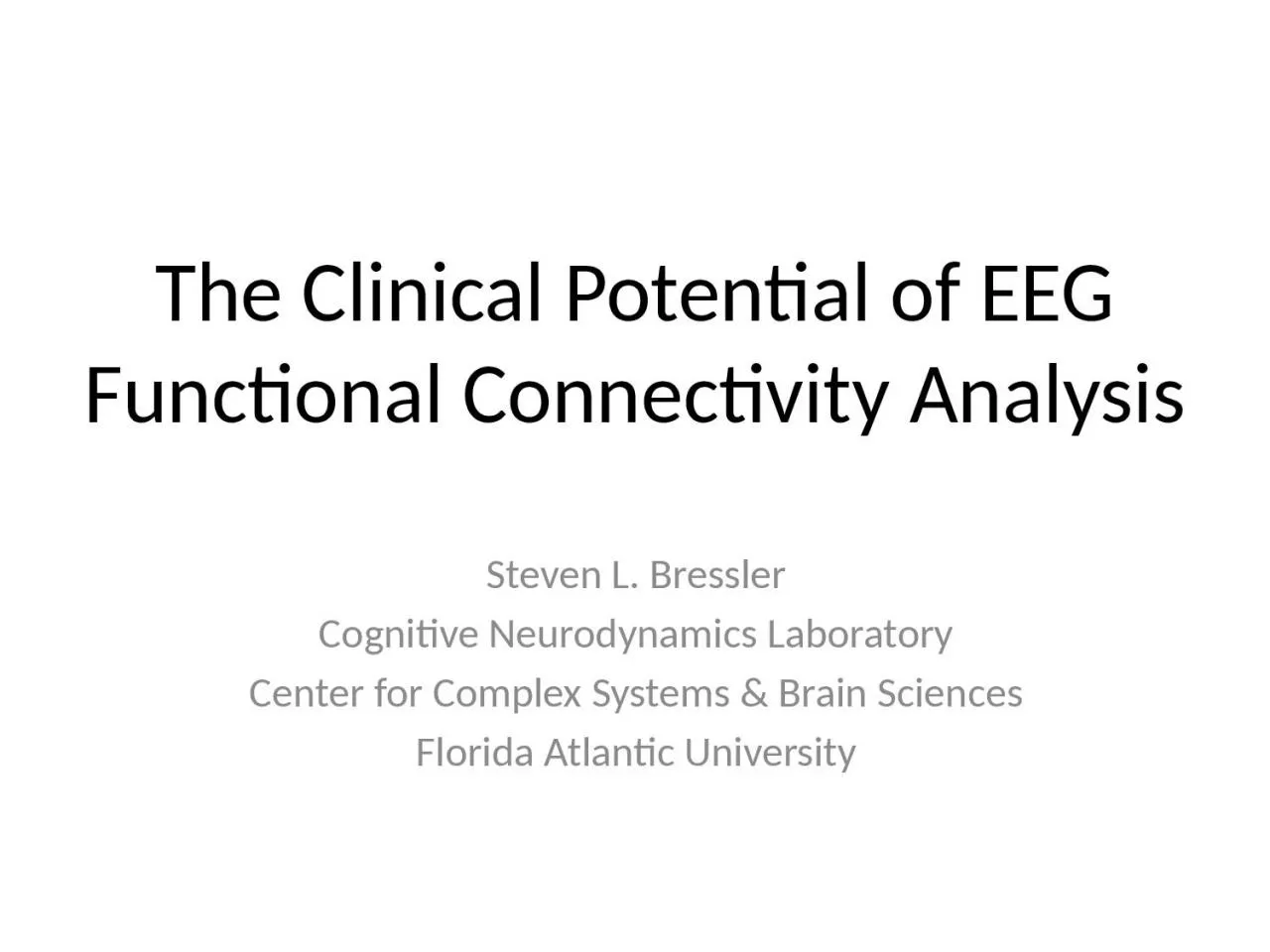

Steven L Bressler Cognitive Neurodynamics Laboratory Center for Complex Systems amp Brain Sciences Florida Atlantic University Overview EEG Source Imaging IOP 2016 1 Functional Connectivity of macaque cortical LFPs ID: 1046835
Download Presentation The PPT/PDF document "The Clinical Potential of EEG Functional..." is the property of its rightful owner. Permission is granted to download and print the materials on this web site for personal, non-commercial use only, and to display it on your personal computer provided you do not modify the materials and that you retain all copyright notices contained in the materials. By downloading content from our website, you accept the terms of this agreement.
1. The Clinical Potential of EEG Functional Connectivity AnalysisSteven L. BresslerCognitive Neurodynamics LaboratoryCenter for Complex Systems & Brain SciencesFlorida Atlantic University
2. OverviewEEG Source Imaging IOP 20161. Functional Connectivity of macaque cortical LFPs a. Sensori-Motor System b. Visual System c. Parieto-Frontal System2. Functional Connectivity of human patient cortical BOLD signals3. Implications for use of Functional Connectivity of human patient EEG source signals
3. Nakamura-Coppola Recording ParadigmEEG Source Imaging IOP 2016Chronic Implant of Bipolar ElectrodesMultiple Distributed Electrode SitesSimultaneous LFP Recording
4. Functional Connectivity of Cortical LFPs in Macaque Prefrontal CortexLiang et al, Neuroreport, 2002EEG Source Imaging IOP 2016Synchronized beta rhythms form a large-scale set-related network.Non-networkPrefrontal
5. Functional Connectivity of Cortical LFPs in Macaque Somatosensory-Motor System Brovelli et al., 2004, PNASMatias et al. 2014, NeuroImageEEG Source Imaging IOP 2016Functional Connectivity analysis using AR-based spectral analysis was successfully applied to Local Field Potentials (LFPs) from the somatosensory & motor cortices in the monkey.Functional Connectivity was seen as interareal oscillatory synchrony & directed influences in the beta frequency range.The flow of directed influence suggested that somatosensory feedback modulates the motor cortex in motor maintenance.
6. Functional Connectivity of Cortical LFPs in Macaque Visual SystemBressler & Richter, 2014, Current Opinion in NeurobiologyEEG Source Imaging IOP 2016Top-down processing in the visual cortex was found to underlie predictive coding & attentional set.Functional Connectivity was seen as interareal oscillatory synchrony & directed influences in the beta frequency range.
7. Gray Recording ParadigmEEG Source Imaging IOP 2016Semi-Chronic ImplantMonopolar ElectrodesMultiple Electrode Sites in 2 RegionsSimultaneous Spike & LFP Recording
8. Functional Connectivity of Cortical LFPs in Macaque Parieto-Frontal SystemSalazar et al., 2012, ScienceEEG Source Imaging IOP 2016Interareal beta frequency synchrony of LFPs from posterior parietal and dorsolateral prefrontal cortices coded for visual working memory content.
9. Functional Connectivity of Cortical BOLD Signals in Human Dorsal Attention SystemBressler et al., 2008, J NeuroscienceTang et al., 2012, PLoS Computational BiologyMeehan, 2016, PhD DissertationEEG Source Imaging IOP 2016Functional Connectivity analysis of the Dorsal Attention Network (DAN), and its interactions with the Visual Occipital Cortex (VOC), revealed that stroke-induced lesions alter intrahemispheric functional connectivity within the DAN and with the VOC, leading to interhemispheric functional connectivity imbalances that strongly correlate with behavioral deficit in spatial-neglect patients.
10. Frequency-Domain Functional Connectivity of Human EEG SourcesEEG Source Imaging IOP 2016Human EEG recording provides a noninvasive fast-timescale signal of brain activity.Human EEG source analysis offers the potential for a noninvasive fast-timescale measure of cortical source activity.Technologies are available to perform human EEG recording with minimal preparation time, mobility, and telemetry.It is technically feasible to perform Functional Connectivity analysis of human EEG cortical source data in real time using high-performance computing.
11. Source Localization & Functional Connectivity AnalysisEEG Source Imaging IOP 2016The key to human frequency-domain functional connectivity analysis of EEG sources is to determine the Primary Current Density (PCD) from the human scalp-recorded EEG. [See Paz-Linares et al. (2016)].To determine the PCD from an arbitrary scalp EEG distribution (V) means solving the inverse problem.To solve the inverse problem, one must know the Electric Lead Field (ELF), which is usually estimated by making assumptions about head geometry and electrical conductivity.Once V and the ELF are known, the PCD can be obtained.
12. Solving the Inverse ProblemEEG Source Imaging IOP 2016Since the number of recording electrodes (N) is typically small compared to the number of generators in the PCD (S), the inverse problem, in general, is ill-posed, i.e., it has many equivalent solutions.Solving the inverse problem thus requires the imposition of additional constraints.
13. Solutions to the Inverse ProblemEEG Source Imaging IOP 2016Valdes-Sosa and colleagues have proposed a mixed-norms approach to the inverse problem, where L1 and L2 penalty functions are used as constraints.Cheung et al. (2010) assume that cortical signals arise from known regions. They propose simultaneously solving state (MVAR model) and observation (relating PCD and scalp EEG) equations to estimate an MVAR model of cortical functional connectivity from the scalp EEG.
14. Take-Home MessageEEG Source Imaging IOP 2016Neurocognitive networks support higher-level functions in the cerebral cortex.Synchronized beta-frequency oscillations underlie neurocognitive network interactions.Techniques are being developed and tested to solve the inverse problem and estimate PCD Functional Connectivity from the scalp EEG.One can envision that Functional Connectivity of human patient EEGs will provide neuromarkers to augment clinical decision-making and provide patient-specific neural information to guide brain stimulation.